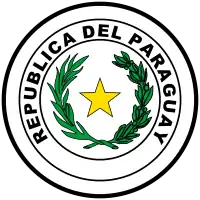Genocide of indigenous peoples in Paraguay
There are 17 indigenous tribes in Paraguay with the majority having their territories in the Chaco region. Tribes in this region include the Guaraní, Ayoreo, Toba-Maskoy, Aché and Sanapan which according to the census from 2002 number an estimated 86,000 or roughly around 2 per cent of the total population. These peoples have faced persecution particularly under the dictator Alfredo Strossner that some observers called a genocide.
Repression under Alfredo Stroessner
Between 1956 and 1989, while under the military rule of General Alfredo Stroessner, the indigenous population had more territory taken than at any other period in Paraguay's history and were subjected to systematic human rights abuses. In 1971, Mark Münzel, a German anthropologist accused Stroessner of attempted genocide against the indigenous peoples of Paraguay[1] and Bartomeu Melià, a Jesuit anthropologist stated that the forced relocations of the indigenous peoples was ethnocide.[2] In the early 1970s the Stroessner regime was charged by international groups of being complicit in genocide. However, because of the repressive actions undertaken by the state the indigenous tribes organized themselves politically and had a major role in bringing about the end of the military dictatorship and the eventual transition to democracy.[3][2][4] The state financed these repressive actions with U.S. aid, which totaled $146 million for the years 1962 to 1975.[5]
Destruction of the Ache tribe
During the 1960s and 1970s, 85 percent of the Aché tribe died, with many hacked to death with machetes to make room for the timber industry, mining, farming and ranchers.[6] One estimate posits this amounts to 900 deaths.[7] According to Jérémie Gilbert, the situation in Paraguay has proven that it is difficult to provide the proof required to show "specific intent", in support of a claim that genocide had occurred. The Aché, whose cultural group is now seen as extinct, fell victim to the development by the state, who had promoted the exploration of Aché territory by transnational companies for natural resources. Gilbert concludes that though planned and voluntary destruction had occurred, it is argued by the state that there was no intent to destroy the Aché, as what had happened was due to development.[8]
Assessment of persecution as a genocide
The allegation of genocide by the state was brought before the Inter-American Human Rights Commission which has jurisdiction on allegations of genocide carried out by a state. The commission gave a provisional ruling that Paraguay had not carried out a genocide, but stated it had concerns over "possible abuses by private persons in remote areas of the territory of Paraguay".[9] The Whitaker Report of the United Nations listed the persecution of the Aché as an example of genocide.[10]
References
- Münzel 1973, p. 5.
- Becker 2010.
- Minority Rights Group International 2007.
- Horst 2003, p. 104.
- Cooper 2008, p. 167.
- Churchill 2000, p. 433.
- Haff, Barbara; Gurr, Ted Robert (1991). "Victims of the State:Genocide, Politicides and Group Repression Since 1945". Institutional Review of Victimology. 1: 23–41.
- Gilbert 2006, p. 118.
- Quigley 2006, p. 125.
- "UN Whitaker Report on Genocide, 1985, paragraphs 14 to 24 pages 5 to 10» ". preventgenocideinternational. Archived from the original on 13 June 2019.
Bibliography
- Becker, Meghan Auker (11 April 2010). "Paraguayan indigenous peoples resist the Stroessner regime, 1969–1989". Global Nonviolent Action Database.
- Churchill, Ward (2000). Israel W. Charny (ed.). Encyclopedia of Genocide. ABC-CLIO. ISBN 978-0874369281.
- Cooper, Allan D. (2008). The Geography of Genocide. University Press of America. ISBN 978-0761840978.
- Gilbert, Jérémie (2006). Indigenous Peoples' Land Rights Under International Law: From Victims to Actors. Transnational. ISBN 978-1571053695.
- Horst, Rene Detlef (2003). "Consciousness and Contradiction". In Erick Detlef Langer, Elena Muñoz (ed.). Contemporary Indigenous Movements in Latin America. Rowman & Littlefield. ISBN 978-0842026802.
- Münzel, Mark (1973). The Aché Indians: genocide in Paraguay (PDF). International Work Group for Indigenous Affairs.
- Quigley, John B. (2006). The Genocide Convention: An International Law Analysis. Ashgate. ISBN 978-0754647300.
- "World Directory of Minorities and Indigenous Peoples – Paraguay : Overview". Minority Rights Group International. 2007.
